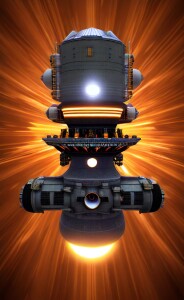The best source of energy for space travel depends on the specific mission requirements, the duration of the journey, and the technology available. In space travel, there are a few primary energy sources that have been and are being considered:
1. Chemical Propulsion: Chemical rockets, which use chemical reactions to produce thrust, have been the primary propulsion method for space travel. They are efficient for short-duration missions within our solar system. However, they require a large amount of propellant and are limited by the energy stored in the chemical bonds.
2. Nuclear Thermal Propulsion: Nuclear thermal propulsion involves using a nuclear reactor to heat a propellant (usually hydrogen) and expel it at high speeds to generate thrust. This method offers higher specific impulse (efficiency) compared to chemical rockets, which makes it suitable for interplanetary travel.
3. Nuclear Electric Propulsion: This approach uses a nuclear reactor to generate electricity, which is then used to power ion or plasma thrusters. Although the thrust generated is low, these engines are highly efficient and can provide continuous thrust over long periods, making them suitable for deep space missions.
4. Solar Power: Solar panels are commonly used to generate electricity for spacecraft. Solar energy can power various systems, including communication, instrumentation, and propulsion for missions in the inner solar system. However, as you move farther from the Sun, solar power becomes less effective.
Radioisotope Thermoelectric Generators (RTGs): RTGs use the heat generated by the decay of radioactive isotopes to produce electricity. They have been used in many deep space missions, such as those to the outer planets and beyond, where solar power is insufficient.
5. Fusion Propulsion: While still largely experimental, fusion propulsion aims to mimic the energy-producing reactions in the sun. If harnessed successfully, fusion could provide a nearly limitless and highly efficient energy source for space travel. However, achieving controlled fusion reactions on a spacecraft remains a significant challenge.
The allure of interstellar travel has woven a spell over both scientific minds and passionate space enthusiasts. The vast expanse of the cosmos presents formidable obstacles, demanding an energy source that can rise to the challenge. Enter fusion power, shining like a beacon of hope for interstellar voyages. Fusion, the awe-inspiring process of merging atomic nuclei to unleash unfathomable energy, is the very force that fuels our mighty sun. Scientists now dream of recreating this cosmic dance on a smaller scale, harnessing fusion’s power to propel us through the stars. Imagine, reactors capable of generating boundless energy from a mere whisper of fuel, ushering in an era of unprecedented efficiency for long-duration space odysseys. But fusion offers more than just raw power; it embodies the promise of clean, sustainable energy. With no greenhouse gases or harmful byproducts to taint the celestial playground, interstellar missions can span eons without leaving a trace. Granted, fusion power faces daunting technical hurdles, like summoning and maintaining scorching temperatures and pressures. Yet, the realm of ongoing research and the ever-advancing frontiers of fusion technology ignite a flame of hope. A future where humanity soars through the cosmos, propelled by the very essence of stars themselves, is not beyond our grasp. Together, we may embark on extraordinary journeys to galaxies far, far away, fueled by the extraordinary potential of fusion energy.

